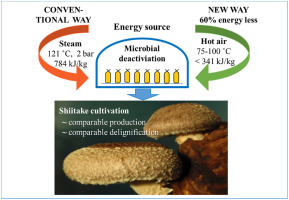当前位置:
X-MOL 学术
›
Renew. Energy
›
论文详情
Our official English website, www.x-mol.net, welcomes your
feedback! (Note: you will need to create a separate account there.)
Energy smart hot-air pasteurisation as effective as energy intense autoclaving for fungal preprocessing of lignocellulose feedstock for bioethanol fuel production
Renewable Energy ( IF 9.0 ) Pub Date : 2020-08-01 , DOI: 10.1016/j.renene.2020.03.154 Maogui Wei , Shaojun Xiong , Feng Chen , Paul Geladi , Lill Eilertsen , Olena Myronycheva , Torbjörn A. Lestander , Mikael Thyrel
Renewable Energy ( IF 9.0 ) Pub Date : 2020-08-01 , DOI: 10.1016/j.renene.2020.03.154 Maogui Wei , Shaojun Xiong , Feng Chen , Paul Geladi , Lill Eilertsen , Olena Myronycheva , Torbjörn A. Lestander , Mikael Thyrel

|
Abstract This study compared the effects of hot-air pasteurisation (HAP) at 75–100 °C versus autoclaving at 121 °C and 2 bar overpressure on the lignocellulosic degradation process of birch-based substrates that were used for shiitake mushroom cultivation and potential bioethanol production. Fifty substrate samples were obtained as a time series from different stages of the cultivation, and their chemical contents were measured by chemical analysis and near infra-red spectroscopy (NIR). Despite of different energy intensities, HAP and autoclaving did not result in significant differences in the degradation of lignin and carbohydrates. Major compositional changes were associated with the cultivation process. Principal component analysis on the wet chemical data and orthogonal projections to latent structures based on NIR spectra reached the same conclusion, namely that HAP had similar effect as autoclaving on compositional changes in the substrate during cultivation. The results of this study suggest that a substitution of autoclaving by HAP may potentially save up to 9.9 TWh energy for the global production of 7.5 million ton shiitake. At the same time, lignocellulose feedstock can be pretreated for the production of up to 3.24 million m3 of 95%-ethanol fuels, which can potentially substitute proximate 1.88 million m3 of regular gasoline.
中文翻译:

能源智能热空气巴氏杀菌与能源密集型高压灭菌一样有效,用于木质纤维素原料的真菌预处理,用于生物乙醇燃料生产
摘要 本研究比较了 75–100 °C 的热空气巴氏杀菌 (HAP) 与 121 °C 和 2 bar 超压下的高压灭菌对用于香菇培养和潜在生物乙醇的桦木基质木质纤维素降解过程的影响。生产。从培养的不同阶段获得了 50 个作为时间序列的基质样品,并通过化学分析和近红外光谱 (NIR) 测量了它们的化学含量。尽管能量强度不同,但 HAP 和高压灭菌在木质素和碳水化合物的降解方面没有显着差异。主要的成分变化与培养过程有关。湿化学数据的主成分分析和基于 NIR 光谱对潜在结构的正交投影得出了相同的结论,即 HAP 对培养过程中基质的成分变化具有与高压灭菌相似的影响。这项研究的结果表明,用 HAP 代替高压灭菌法可能为全球 750 万吨香菇的生产节省高达 9.9 TWh 的能源。同时,木质纤维素原料可以进行预处理,以生产多达 324 万立方米 95% 乙醇燃料,这有可能替代约 188 万立方米的普通汽油。这项研究的结果表明,用 HAP 代替高压灭菌法可能为全球 750 万吨香菇的生产节省高达 9.9 TWh 的能源。同时,木质纤维素原料可以进行预处理,以生产多达 324 万立方米 95% 乙醇燃料,有可能替代约 188 万立方米的普通汽油。这项研究的结果表明,用 HAP 代替高压灭菌法可能为全球 750 万吨香菇的生产节省高达 9.9 TWh 的能源。同时,木质纤维素原料可以进行预处理,以生产多达 324 万立方米 95% 乙醇燃料,有可能替代约 188 万立方米的普通汽油。
更新日期:2020-08-01
中文翻译:

能源智能热空气巴氏杀菌与能源密集型高压灭菌一样有效,用于木质纤维素原料的真菌预处理,用于生物乙醇燃料生产
摘要 本研究比较了 75–100 °C 的热空气巴氏杀菌 (HAP) 与 121 °C 和 2 bar 超压下的高压灭菌对用于香菇培养和潜在生物乙醇的桦木基质木质纤维素降解过程的影响。生产。从培养的不同阶段获得了 50 个作为时间序列的基质样品,并通过化学分析和近红外光谱 (NIR) 测量了它们的化学含量。尽管能量强度不同,但 HAP 和高压灭菌在木质素和碳水化合物的降解方面没有显着差异。主要的成分变化与培养过程有关。湿化学数据的主成分分析和基于 NIR 光谱对潜在结构的正交投影得出了相同的结论,即 HAP 对培养过程中基质的成分变化具有与高压灭菌相似的影响。这项研究的结果表明,用 HAP 代替高压灭菌法可能为全球 750 万吨香菇的生产节省高达 9.9 TWh 的能源。同时,木质纤维素原料可以进行预处理,以生产多达 324 万立方米 95% 乙醇燃料,这有可能替代约 188 万立方米的普通汽油。这项研究的结果表明,用 HAP 代替高压灭菌法可能为全球 750 万吨香菇的生产节省高达 9.9 TWh 的能源。同时,木质纤维素原料可以进行预处理,以生产多达 324 万立方米 95% 乙醇燃料,有可能替代约 188 万立方米的普通汽油。这项研究的结果表明,用 HAP 代替高压灭菌法可能为全球 750 万吨香菇的生产节省高达 9.9 TWh 的能源。同时,木质纤维素原料可以进行预处理,以生产多达 324 万立方米 95% 乙醇燃料,有可能替代约 188 万立方米的普通汽油。











































 京公网安备 11010802027423号
京公网安备 11010802027423号